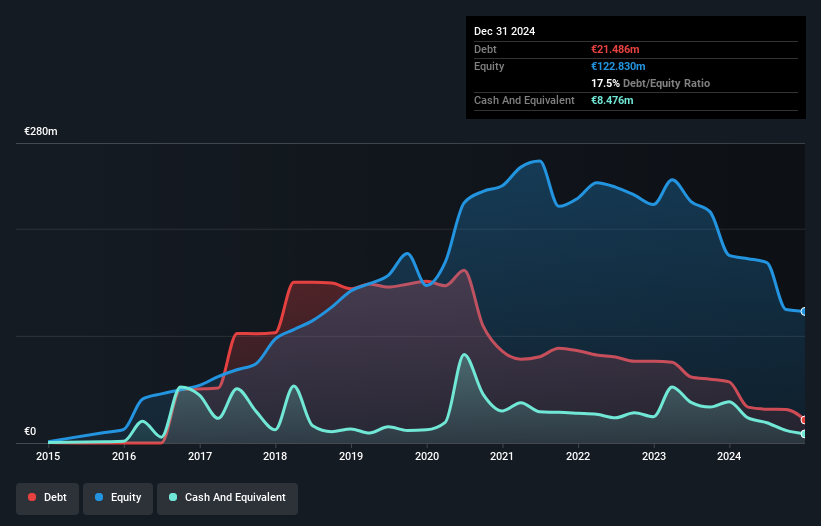Here's Why Catena Media (STO:CTM) Can Afford Some Debt
The external fund manager backed by Berkshire Hathaway's Charlie Munger, Li Lu, makes no bones about it when he says 'The biggest investment risk is not the volatility of prices, but whether you will suffer a permanent loss of capital.' So it might be obvious that you need to consider debt, when you think about how risky any given stock is, because too much debt can sink a company. Importantly, Catena Media plc (STO:CTM) does carry debt. But is this debt a concern to shareholders?
We've discovered 2 warning signs about Catena Media. View them for free.When Is Debt A Problem?
Debt assists a business until the business has trouble paying it off, either with new capital or with free cash flow. If things get really bad, the lenders can take control of the business. While that is not too common, we often do see indebted companies permanently diluting shareholders because lenders force them to raise capital at a distressed price. Of course, plenty of companies use debt to fund growth, without any negative consequences. The first thing to do when considering how much debt a business uses is to look at its cash and debt together.
What Is Catena Media's Net Debt?
You can click the graphic below for the historical numbers, but it shows that Catena Media had €21.5m of debt in December 2024, down from €57.0m, one year before. However, because it has a cash reserve of €8.48m, its net debt is less, at about €13.0m.

A Look At Catena Media's Liabilities
The latest balance sheet data shows that Catena Media had liabilities of €23.6m due within a year, and liabilities of €370.0k falling due after that. Offsetting these obligations, it had cash of €8.48m as well as receivables valued at €26.7m due within 12 months. So it actually has €11.2m more liquid assets than total liabilities.
This surplus liquidity suggests that Catena Media's balance sheet could take a hit just as well as Homer Simpson's head can take a punch. With this in mind one could posit that its balance sheet means the company is able to handle some adversity. When analysing debt levels, the balance sheet is the obvious place to start. But you can't view debt in total isolation; since Catena Media will need earnings to service that debt. So if you're keen to discover more about its earnings, it might be worth checking out this graph of its long term earnings trend.
Check out our latest analysis for Catena Media
In the last year Catena Media had a loss before interest and tax, and actually shrunk its revenue by 35%, to €50m. That makes us nervous, to say the least.
Caveat Emptor
While Catena Media's falling revenue is about as heartwarming as a wet blanket, arguably its earnings before interest and tax (EBIT) loss is even less appealing. Its EBIT loss was a whopping €2.2m. That said, we're impressed with the strong balance sheet liquidity. That should give the business time to grow its cashflow. The company is risky because it will grow into the future to get to profitability and free cash flow. There's no doubt that we learn most about debt from the balance sheet. But ultimately, every company can contain risks that exist outside of the balance sheet. For instance, we've identified 2 warning signs for Catena Media (1 shouldn't be ignored) you should be aware of.
If, after all that, you're more interested in a fast growing company with a rock-solid balance sheet, then check out our list of net cash growth stocks without delay.
New: AI Stock Screener & Alerts
Our new AI Stock Screener scans the market every day to uncover opportunities.
• Dividend Powerhouses (3%+ Yield)
• Undervalued Small Caps with Insider Buying
• High growth Tech and AI Companies
Or build your own from over 50 metrics.
Have feedback on this article? Concerned about the content? Get in touch with us directly. Alternatively, email editorial-team (at) simplywallst.com.
This article by Simply Wall St is general in nature. We provide commentary based on historical data and analyst forecasts only using an unbiased methodology and our articles are not intended to be financial advice. It does not constitute a recommendation to buy or sell any stock, and does not take account of your objectives, or your financial situation. We aim to bring you long-term focused analysis driven by fundamental data. Note that our analysis may not factor in the latest price-sensitive company announcements or qualitative material. Simply Wall St has no position in any stocks mentioned.
About OM:CTM
Catena Media
Provides affiliation marketing services for operators of online sports betting and casino platforms in North America and Latin America.
Flawless balance sheet with low risk.
Similar Companies
Market Insights
Community Narratives



